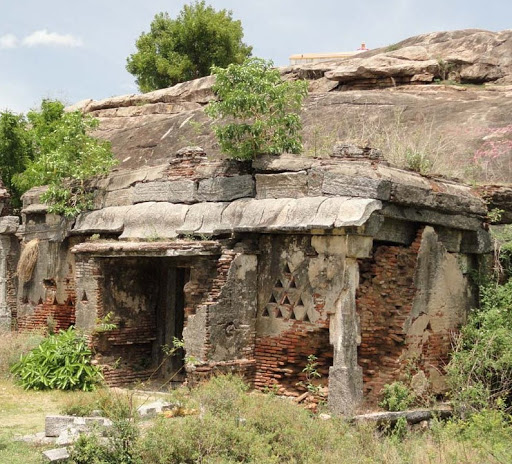Sri-Sikhari-Pallaveshvaram Cave Temple, Gingee

Address
Sri-Sikhari-Pallaveshvaram Cave Temple, Melacheri Village, Gingee, Villupuram, Tamil Nadu 604202, India
Diety
Maddileshvara (Shiva )
Introduction
Melacheri is a small village located near Gingee. There is a small cave excavation, which is always locked it seems. Cave Temple – This cave temple is excavated in the western face of a small granite boulder, located to the north of the village. This seem to be a live temple, however the lock on the gates was so old and rusty that it seems that the gates are not opened from a long time. Locally this temple is known as Maddileshvara temple. There is a modern Murugan temple on nearby hill, which seems to be more in worship in comparison to this cave temple. The façade faces the west and is opposite to an irrigation tank. This rock temple is hidden by a later addition of brick mandapa in front of the cave. In the center of the cave are two pillars, and two pilasters which are square throughout. This arrangement divided the cave into three partitions of equal size. The corbel above the pillars is in angular profile, not in curved or Taranga (roll) profile as seen in other Mahendra shrines. It houses a Shiva lingam, which is cylindrical in form and resting on yoni pedestal. The pedestal is about 4.75 feet above the floor level. This stone Shiva lingam is carved from the original rock, a feature not seen in any other Pallava cave of Mahendra or later time. There is a lotus carved on the ceiling just above this lingam. The north wall of the cave has a niche cut into and there stands an image of Parvati. A Nandi is placed now facing opposite to the cave temple as well. The temple is only open for few hours and on certain days, therefore getting a look of inside is little difficult in case you are not on the spot at the right time.
Puranic Significance
The temple was included in the Pallava antiquities compiled by Dubreuil2. He got curious after reading in the gazetteer about the rock-cut linga. During his visit, he discovered the inscription written in the Pallava Grantha script. He concludes that the temple belongs to the middle of seventh century CE and may be credited either to the Pallava king Narasimhavarman I (630-668 CE) or to Parameswaravarman I (670-695 CE) explaining that Chandraditya mentioned in the inscription appears to be a name of either of these kings. This temple in his list of Pallava temples of early period. He mentions that Chandraditya is evidently a name of a Pallava king however whose we cannot say with certainty.
Century/Period/Age
7th century AD
Managed By
–
Nearest Bus Station
Melacheri Village
Nearest Railway Station
Villupuram
Nearest Airport
Pondichery









